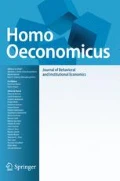Abstract
This article explores several issues related to whether and how direct participation of citizens could be further developed in democratic systems. The analysis starts with an overview of Frey’s proposals for a democracy of the future. The article then addresses three main issues related to direct citizen involvement in public decision-making: (1) the link between extensive direct participation rights and Pareto optimality; (2) the question whether political parties do matter in representative democracies; and (3) the role of program evaluation in our modern democracies. The main conclusion of the analysis is that, given the current state of the literature, the search for Pareto-optimal policies does not appear as either a necessary condition (representative democracies have merits on their own) or a sufficient condition (referendums can yield inefficient outcomes) for extended democratic participation rights.
Similar content being viewed by others
References
Asatryan, Z., & De Witte, K. (2015). Direct democracy and local government efficiency. European Journal of Political Economy, 39, 58–66.
Beath, A., Christia, F., & Enikolopov, R. (2017). Direct democracy and resource allocation: Experimental evidence from Afghanistan. Journal of Development Economics., 124, 199–213.
Berg, S., & Holler, M. J. (1986). Randomized decision rules in voting games: A model for strict proportional power. Quality & Quantity, 20, 419–429.
Besley, T. (2006). Principled agents?: The political economy of good government. Oxford: Oxford University Press.
Brennan, J. (2016). Against democracy. Princeton: Princeton University Press.
Bruce, C., & Clark, J. (2010). The efficiency of direct public involvement in environmental policymaking: An experimental test. Environmental & Resource Economics, 45, 157–182.
Buchanan, J. M., & Tullock, G. (1962). The calculus of consent: Logical foundations of constitutional democracy. Carmel: Liberty Fund Inc.
Esterling, K. M. (2009). The political economy of expertise: Information and efficiency in american national politics. Ann Arbor: University of Michigan Press.
European Commission. (2011). The programming period 2014–2020. Monitoring and evaluation of European Cohesion Policy. European Commission Report.
Feld, L. P., & Kirchgässner, G. (1999). Public debt and budgetary procedures: Top down or bottom up? Some evidence from Swiss municipalities. In J. M. Poterba & J. Hagen (Eds.), Fiscal institutions and Fiscal performance (pp. 151–179). Chicago: Chicago University Press and NBER.
Feld, L. P., & Kirchgässner, G. (2000). Direct democracy, political culture, and the outcome of economic policy: A report on the Swiss experience. European Journal of Political Economy, 16, 287–306.
Ferris, S. J., Park, S.-B., & Winer, S. L. (2008). Studying the role of political competition in the evolution of government size over long horizons. Public Choice, 137, 369–401.
Fox, S., & Johnston, R. (2017). Well-intentioned fantasy? A comment on ‘Proposals for a Democracy of the Future’ by Bruno Frey. Homo Oeconomicus, 34, 229–235.
Freier, R., & Odendahl, C. (2015). Do parties matter? Estimating the effect of political power in multi-party systems. European Economic Review, 80, 310–328.
Frey, B. S. (2017). Proposals for a democracy of the future. Homo Oeconomicus, 34, 1–9.
Frey, B. S., & Stutzer, A. (2000). Happiness, economy and Institutions. Economic Journal, 110, 918–938.
Frey, B. S., & Stutzer, A. (2002). Happiness and economics. Princeton: Princeton University Press.
Josselin, J.-M., & Le Maux, B. (2017). Statistical tools for program evaluation: Methods and applications to economic policy, public health, and education. Berlin: Springer.
Kendall, R. (2017). Aligning democracy: A comment on Bruno S. Frey’s ‘Proposals for a Democracy of the Future’. Homo Oeconomicus, 34, 243–251.
Kirchgässner, G. (2015). Direct democracy, changes and challenges. CREMA working paper no 2015–09. CREMA—Center for Research in Economics, Management and the Arts, Switzerland.
Le Maux, B., Dostálová, K., & Padovano, F. (2017). Ideology and public policies: A quasi-experimental test of the hypothesis that left-wing governments spend more. Economics working paper from Condorcet Center for Political Economy at CREM-CNRS. 2017-01-ccr.
Matsusaka, J. G. (2010). Popular control of public policy: A quantitative approach. Quarterly Journal of Political Science, 5, 133–167.
Mueller, D. C. (2003). Public choice III. Cambridge: Cambridge University Press.
Nurmi, H. (2017). Reforming democracy: Comment on ‘Proposals for a Democracy of the Future’ by Bruno Frey. Homo Oeconomicus, 34, 201–205.
OECD. (2006). Cost–benefit analysis and the environment recent developments. Paris: OECD Publishing.
Pettersson-Lidbom, P. (2008). Do parties matter for economic outcomes? A regression-discontinuity approach. Journal of the European Economic Association, 6, 1037–1056.
Saaty, T. L., & Shang, J. S. (2007). Group decision-making: Head-count versus intensity of preference. Socio-Economic Planning Sciences, 41, 22–37.
Samuelson, P. A. (1954). The theory of public expenditure. Review of Economics and Statistics, 36, 386–389.
Schneider, F., & Pommerehne, W. W. (1983). Macroeconomia della crescita in disequilibrio e settore pubblico in espansione: il peso delle differenze istituzionali. Rivista Internazionale di Scienze Economiche e Commerciali, 33, 306–420.
Schofield, N. (2017). Comment on ‘Proposals for a Democracy of the Future’ by Bruno Frey. Homo Oeconomicus, 34, 191–194.
Towfigh, E. V., Goerg, S. J., Glöckner, A., Leifeld, P., Llorente-Saguer, A., Bade, S., et al. (2016). Do direct-democratic procedures lead to higher acceptance than political representation? Public Choice, 167, 47–65.
Voigt, S., & Blume, L. (2015). Does direct democracy make for better citizens? A cautionary warning based on cross-country evidence. Constitutional Political Economy, 26, 391–420.
Acknowledgements
The author would like to thank Kristýna Dostálová and Manfred Holler for their valuable comments.
Author information
Authors and Affiliations
Corresponding author
Rights and permissions
About this article
Cite this article
Le Maux, B. On the Necessary and Sufficient Condition for Increasing Direct Participation Rights in Democracies: Comment on “Proposals for a Democracy of the Future” by Bruno S. Frey. Homo Oecon 35, 101–109 (2018). https://doi.org/10.1007/s41412-018-0063-x
Received:
Accepted:
Published:
Issue Date:
DOI: https://doi.org/10.1007/s41412-018-0063-x




